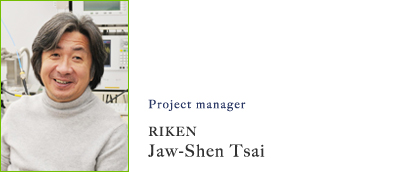
The idea of quantum cybernetics rests on the fusion of two pinnacles of 20th century scientific achievements: “quantum mechanics” and “information science”. The fusion of these two breakthroughs would result in creation of a new paradigm in the basic science of information and control that has the potential to start a revolution in many branches of science and technology in the 21st century. Considering information technology, by controlling “classical” states, to date, the digital information processing has been a dominating power. However, for the next-generation information technology that harnessing the “quantum” states, the more analog-like approach of cybernetics is preferred.
In quantum cybernetics, the coherent control, retention, and transmission of quantum states in various physical systems are studied with a unified viewpoint in interdisciplinary collaboration. The research is carried out by coherent manipulation of solid-state devices such as superconducting devices and in semiconductor devices; as well as microscopic system such as molecules, atoms, ions, and photon. Hybrid quantum systems combining microscopic and macroscopic quantum systems are also studied in collaboration with researchers from various fields. Quantum cybernetics can be applied to information processing and is expected to be a next-generation technology that offers revolutionary performance free from the limits of the principles of classical computers. One of the primary focuses of the research is to realize quantum computation. Research is also performed on various quantum detectors and quantum light sources, and clock synchronization exceeding quantum limits, with a view to application to a variety of areas.
The objectives of research are (1) to achieve quantum control and detection of new quantum systems, (2) to identify the physics of the control and detection of comprehensive, coherent quantum states in various physical systems, and (3) to consider applying the above results to applications such as quantum computing. This research covers a wide range of physical systems and is expected to produce many new results. Some anticipated results are described below, taking interdisciplinary researches that newly opened up by this innovative area of research project as examples.
A hybrid quantum system in which dissimilar quanta are coherently connected to each other is taken as an example to show the direction of the new research. A typical example of such a system is a type of cavity resonator experiment referred to as cavity quantum electrodynamics (QED), in which atoms and photons interact with each other. As a result of these experiments, single-atom lasing and two-quantum-bit photon gates have been achieved. In recent years, remarkable advances have been made in artificial atom (qubit) research based on solid-state devices, leading to a completely new area of research on quantum control (which could be called “artificial atom quantum optics”) in which the above experiments can be performed using artificial atoms and a resonator. Being much larger than naturally occurring atoms, artificial atoms are strongly coupled to the resonator, allowing a strong-coupling regime to be easily attained (the coupling energy is very large compared with the relaxation time of artificial atoms and the resonator). In addition, they do not move, unlike natural atoms. By making use of these characteristics, single-artificial-atom lasing (an achievement of the RIKEN group proposing this research; published in Nature in 2007) and the coupling of multiple artificial atoms (quantum bits) via the resonator have been achieved. A hybrid quantum system in which the electron state of artificial atoms and the photon state of the resonator are allowed to coherently co-exist and to be coupled offers freedom of circuit design, therefore it has the potential for further significant developments. For example, it is expected to achieve accurate control of the number of photons through gate control and single-photon sources that allow single photons to be generated at will. Various new advances, such as two-qubit photon gates and large integrated-qubit circuits using a photon resonator, are expected to be made.
”Artificial atomic quantum acoustics” research, in which artificial atoms are coupled to a nanoscale mechanical resonator instead of a photon resonator, is underway. A mechanical system has a very large macroscopic degree of freedom. Its quantization and coherent manipulation will be a revolutionary achievement. During the period of this research, we aim to achieve results that lead to phonon lasing and single-phonon sources. We also intend to study various integrated quantum systems to achieve a hybrid quantum system combining naturally atoms and solid state artificial atoms. Research targeted at realizing quantum metamaterials by arranging artificial atoms to form a solid material is planned. High expectations are focused on research aimed at basic science required to realize quantum computation. Implementation of quantum algorithms and quantum error correction, demonstration of quantum nondestructive detection, and other basic functions that are essential to quantum information processing will be studied.
Ministry of Education, Culture, Sports, Science and Technology website for Scientific Research on Innovative Areas (Proposal-based Research):
→ http://www.mext.go.jp/english/













